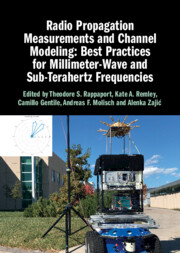Book contents
- Frontmatter
- Dedication
- Contents
- Contributors
- Preface
- 1 Introduction
- 2 Estimating Channel Characteristics from Measurements
- 3 Channel Sounders
- 4 Verification Techniques
- 5 Introduction to Millimeter-Wave Channel Modeling
- 6 Path Loss/Shadowing
- 7 Multipath Component Clustering
- 8 Dispersion Characteristics
- 9 Peer-to-Peer Networking
- 10 Temporal Variance: Literature Review on Human Blockage Models
- 11 Terahertz Channels
- 12 Connection between the Measurements and Models
- 13 Conclusions
- Index
8 - Dispersion Characteristics
Published online by Cambridge University Press: 18 August 2022
- Frontmatter
- Dedication
- Contents
- Contributors
- Preface
- 1 Introduction
- 2 Estimating Channel Characteristics from Measurements
- 3 Channel Sounders
- 4 Verification Techniques
- 5 Introduction to Millimeter-Wave Channel Modeling
- 6 Path Loss/Shadowing
- 7 Multipath Component Clustering
- 8 Dispersion Characteristics
- 9 Peer-to-Peer Networking
- 10 Temporal Variance: Literature Review on Human Blockage Models
- 11 Terahertz Channels
- 12 Connection between the Measurements and Models
- 13 Conclusions
- Index
Summary
When designing a wireless communication system, it is essential to have a channel model that can quickly and accurately generate channel impulse response needed for system simulations. Deterministic models such as ray-tracing offer an accurate model of the propagation environment, but their high computational complexity prohibits the intensive link or system-level simulations required during system design. Hence, models with lower computational complexity that could emulate a large class of radio-propagation environments are preferred. These requirements have led to stochastic channel models, which are often classified into geometry-based stochastic models (GSCMs) and nongeometrical stochastic models. In this chapter we focus on the GSCM models.
Keywords
Information
- Type
- Chapter
- Information
- Radio Propagation Measurements and Channel Modeling: Best Practices for Millimeter-Wave and Sub-Terahertz Frequencies , pp. 153 - 210Publisher: Cambridge University PressPrint publication year: 2022
